Grade 10 Exam > Grade 10 Notes > Physics for Grade 10 > Circular & Non-Circular Orbits
Circular & Non-Circular Orbits | Physics for Grade 10 PDF Download
| Table of contents |

|
| Orbital Motion |

|
| Circular Motion in an Orbit |

|
| Circular Orbits |

|
| Non-Circular Orbits |

|
Orbital Motion
- There are many orbiting objects in our solar system
- They each orbit a different type of planetary body
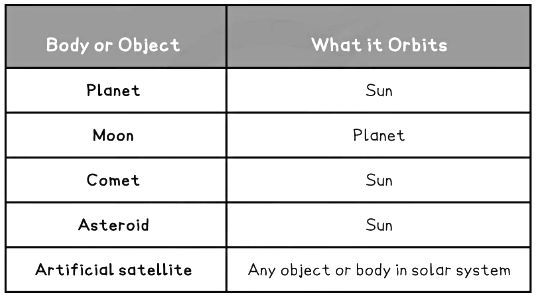 Orbiting Objects or Bodies in Our Solar System Table
Orbiting Objects or Bodies in Our Solar System Table
- A smaller body or object will orbit a larger body
- In order to orbit a body such as a star or a planet, there has to be a force pulling things towards that body
- Gravity provides this force
- The gravitational force exerted by the larger body on the orbiting object is always attractive
- Therefore, the gravitational force always acts towards the centre of the larger body
- The gravitational force is the centripetal force as it will cause the body to move and maintain in a circular path
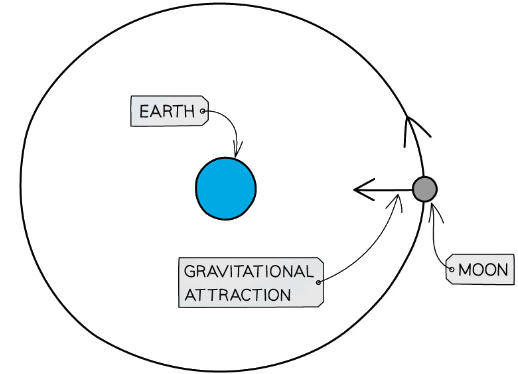
Gravitational attraction causes the Moon to orbit around the Earth
Circular Motion in an Orbit
- Planets travel around the Sun in orbits that are (approximately) circular
- Objects in circular orbit are travelling at a constant speed
- The orbit is a circular path, therefore the direction in which the object is travelling will be constantly changing direction
- A change in direction causes a change in velocity
- Acceleration is the rate of change of velocity, therefore if the object is constantly changing direction then its velocity is constantly changing and so the object in orbit is accelerating
- A resultant force is needed to cause an acceleration
- This resultant force is gravity and it must act at right angles to the instantaneous velocity of the object to create a circular orbit
- This is always towards the centre of the orbit
- The instantaneous velocity of the object is the velocity at a given time
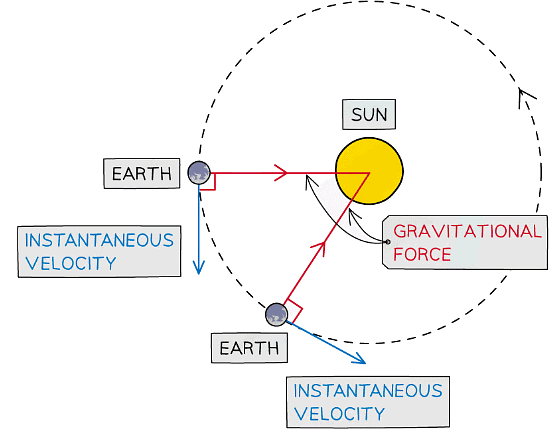 The direction of the instantaneous velocity and the gravitational force at different points of the Earth’s orbit around the sun
The direction of the instantaneous velocity and the gravitational force at different points of the Earth’s orbit around the sun
Exam Tip
When you are describing the motion of an object in orbit make sure you describe the correct terminology. Speed is a scalar quantity, it has a magnitude (size) only. Velocity is a vector quantity, it has both a magnitude (size) and a direction.
Circular Orbits
Planets
- There are several similarities in the way different planets orbit the Sun:
- Their orbits are all slightly elliptical (stretched circles) with the Sun at one focus (approximately the centre of the orbit)
- They all orbit in the same plane
- They all travel the same direction around the Sun
- There are also a few differences:
- They orbit at different distances from the Sun
- They orbit at different speeds
- They all take different amounts of time to orbit the Sun
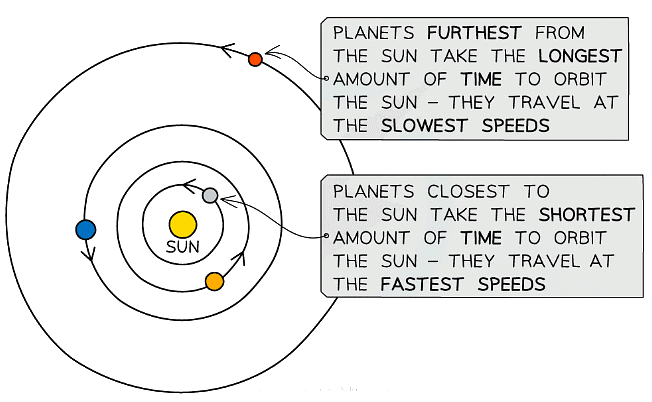 Orbit of planets around the Sun
Orbit of planets around the Sun
Moons
- Moons will orbit planets in a circular path
- Some planets will have more than one moon
- The closer the moon is to the planet:
- The shorter the time it will take to orbit
- The greater the speed in the orbit
Artificial Satellites
- A satellite needs to travel at a specific speed to maintain a circular orbit at a particular distance from the object
- If the speed of the satellite is too big:
- The radius of the orbit will increase and the satellite will spiral into space
- This is because the gravitational attraction cannot provide enough force to keep it in orbit
- If the speed of the satellite is too small:
- The radius of the orbit will decrease and the satellite will move towards the object it should be orbiting
- This is because the gravitational attraction is too strong to maintain a constant orbital radius
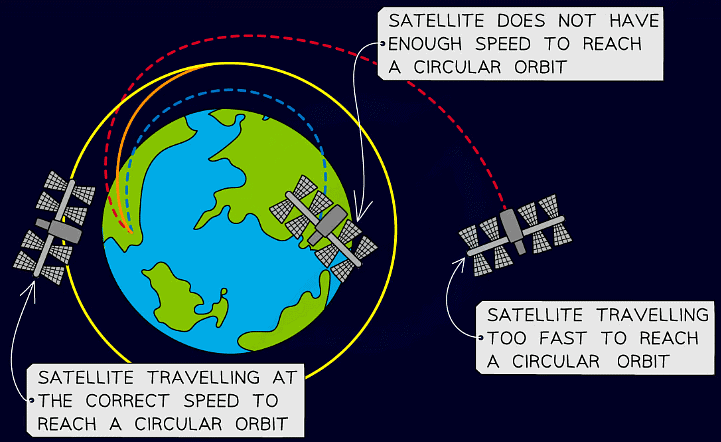 Diagram showing how the speed of an artificial satellite affects its orbit
Diagram showing how the speed of an artificial satellite affects its orbit
- If an artificial satellite is to change the radius at which it is orbiting then the speed at which it is travelling must change
- To maintain a stable orbit:
- If the speed increases the radius must increase
- If the speed decreases the radius must decrease
Non-Circular Orbits
Orbit of a Comet
- The orbits of comets are very different to those of planets:
- The orbits are highly elliptical (very stretched circles) or hyperbolic
- This causes the speed of the comets to change significantly as its distance from the Sun changes
- Not all comets orbit in the same plane as the planets and some don’t even orbit in the same direction
 Orbital path of a comet
Orbital path of a comet
- As the comet approaches the Sun, it loses gravitational potential energy and gains kinetic energy
- This causes the comet to speed up
- This increase in speed causes a slingshot effect, and the body will be flung back out into space again, having passed around the Sun
- As it moves away from the Sun the body will slow down, eventually finishing its orbit and falling back into towards the Sun once more
- In this way, a stable orbit is formed
The document Circular & Non-Circular Orbits | Physics for Grade 10 is a part of the Grade 10 Course Physics for Grade 10.
All you need of Grade 10 at this link: Grade 10
|
124 videos|149 docs|37 tests
|

|
Explore Courses for Grade 10 exam
|

|
Signup for Free!
Signup to see your scores go up within 7 days! Learn & Practice with 1000+ FREE Notes, Videos & Tests.
Related Searches
















